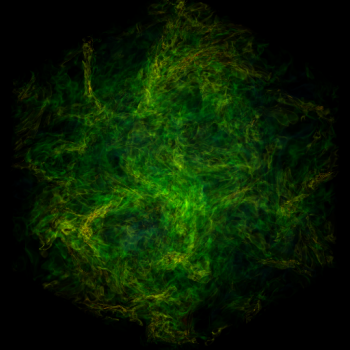NASA-funded ASU study explores turbulence in molecular clouds

An image showing distribution of material on a slice taken out of one of the turbulence simulations. The colors represent density, with dark blue indicating the least dense regions and red indicating the densest regions. The black dots show the positions of the tracer particles, which travel along with the material and record the conditions they encounter, building up a history of how pockets of density change over time. Image courtesy ASU/Scannapeico
On an airplane, motions of air on both small and large scales contribute to turbulence, which may result in a bumpy flight. But turbulence on a much larger scale plays an important in how stars form in giant molecular clouds that permeate the Milky Way.
In a new NASA-funded study published in the journal Science Advances, scientists created simulations to explore how turbulence interacts with cloud density. Lumps, or pockets of density, are the places where new stars are born. Our sun, for example, formed 4.6 billion years ago in a lumpy portion of a cloud that collapsed.
“We know that the main process that determines when and how quickly stars are made is turbulence, because it gives rise to the structures that create stars,” said Evan Scannapieco, professor of astrophysics at Arizona State University's School of Earth and Space Exploration and lead author of the study. “Our study uncovers how those structures are formed.”
Giant molecular clouds are full of random, turbulent motions, which are caused by gravity — stirred by the galactic arms and winds, jets and explosions from young stars. This turbulence is so strong that it creates shocks that drive the density changes in the cloud.
The simulations used dots called tracer particles to traverse a molecular cloud and travel along with the material within. As the particles travel, they record the density of the part of the cloud they encounter, building up a history of how pockets of density change over time.
The researchers — including Liubin Pan from Sun Yat Sen University in China; Marcus Brüggen from the University of Hamburg in Germany; and Ed Buie II from Vassar College in Poughkeepsie, New York — ran the simulations eight times with different characteristics of the cloud.
The team found that the speeding-up and slowing-down of shocks plays an essential role in the path of the particles. Shocks slow down as they go into high-density gas and speed up as they go into low-density gas. This is akin to how an ocean wave strengthens when it hits shallow water by the shore.
When a particle hits a shock, the area around it becomes more dense. But because shocks slow down in dense regions, once lumps become dense enough, the turbulent motions can’t make them any denser. These lumpiest high-density regions are where stars are most likely to form.
While other studies have explored molecular cloud density structures, this simulation allows scientists to see how those structures form over time. This informs scientists’ understanding of how and where stars are likely to be born.
“Now we can understand better why those structures look the way they do because we’re able to track their histories,” Scannapieco said.
NASA’s James Webb Space Telescope is exploring the structure of molecular clouds. It is also exploring the chemistry of molecular clouds, which depends on the history of the gas modeled in the simulations. Scientists hope that new measurements like these will further inform our understanding of star formation.
Written by Elizabeth Landau, NASA Headquarters, NASA Astrophysics, with contributions from Arizona State University.
More Science and technology

Stuck at the airport and we love it #not
Airports don’t bring out the best in people.Ten years ago, Ashwin Rajadesingan was traveling and had that thought. Today, he is an assistant professor at the University of Texas at Austin, but back…

ASU in position to accelerate collaboration between space, semiconductor industries
More than 200 academic, business and government leaders in the space industry converged in Tempe March 19–20 for the third annual Arizona Space Summit, a statewide effort designed to elevate…

A spectacular celestial event: Nova explosion in Northern Crown constellation expected within 18 months
Within the next year to 18 months, stargazers around the world will witness a dazzling celestial event as a “new” star appears in the constellation Corona Borealis, also known as the Northern Crown.…


